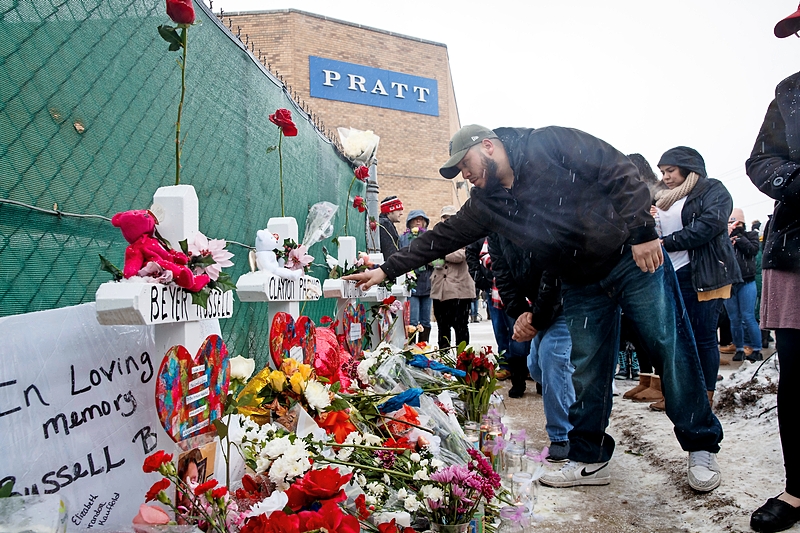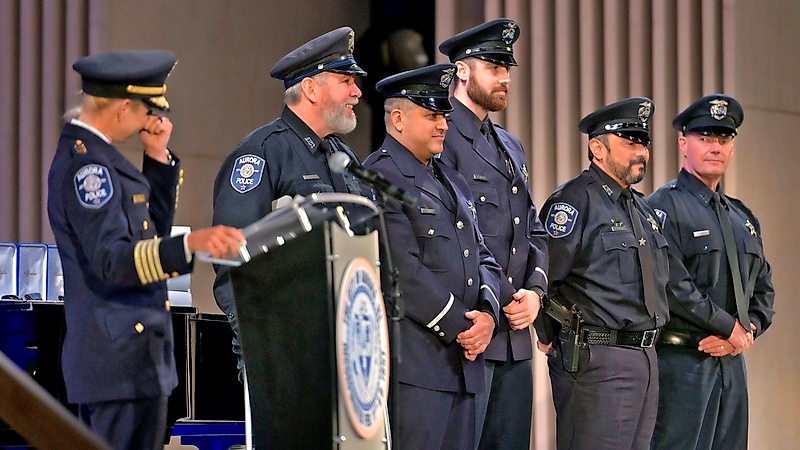Aurora Strong
By Naperville Magazine
February 2020 View more 630
By Christie Willhite

Even as her officers were sweeping Henry Pratt Co. to subdue a gunman, Aurora police chief Kristen Ziman knew the shooting would delineate “before” and “after” for her department—and for the city.
“I was in the command post … and I did have a moment that was surreal,” she says. “I thought, ‘This is happening in my city.’ ”
Ziman quickly brought herself back to the job at hand: overseeing the operation to stop the shooter, rescue employees, and help the wounded. The shooting on February 15, 2019, left five Pratt employees and the gunman dead. Five Aurora officers were wounded, three of whom have since returned to active duty.
And Aurora was added to the growing list of communities that have experienced a mass shooting. A database compiled by the Associated Press, USA Today and Northeastern University shows that there were more mass killings in 2019 than any other year.
“We became ‘Aurora Strong,’ ” Mayor Richard Irvin says of his city’s response. “Not because we wanted to be on that list, but because it made us look at who we are as a community.”
Culture change
It’s a year later, but for Ziman and the officers in her department, “It feels like just a couple months ago,” she says. “It’s so very fresh. We’re recovering, but we’re not close to being there.”
In some ways, doing the job is the easy part, Ziman says. Police officers are trained to handle the next call, to respond to the moment, to do what needs to be done. It’s the quiet moments that are the hardest.
That’s when the officers who were in the gun battle have time to wonder whether they could’ve done something differently that would have saved a life or prevented an injury. It’s when officers who weren’t on the scene grapple with survivor’s guilt for not being there to back up their fellow officers.
“I’ve been trying to change the culture of asking for help,” Ziman says, noting the high suicide rate among first responders. “As a profession, we have a tendency to say, ‘Suck it up and handle the pain,’ “ she says. “These guys are big and strong, and yet they’re broken.”
Ziman and the department have encouraged officers, 911 operators, and staff to talk with mental health workers, a standard practice after a trauma, the chief says. But rather than viewing the critical stress debriefing as a one-and-done requirement, many in the department—and their families—are coming to see extended counseling as necessary to their emotional well-being.
“Our culture is changing,” Ziman says. “It’s been my battle cry, but I don’t think we lend enough credence to the followers for doing it.”
Lessons learned and shared
When the call came in, both Ziman and Irvin say they went on autopilot, relying on their own training and that of staff and first responders to carry everyone through the crisis.
“We immediately recognized the value of the training we’d had in the past, and how much we need our training in the future,” Irvin says.
Aurora officers take eight-hour training sessions six times each year. They study active shooter situations, analyze perpetrator behavior, and learn from the tactical response. It’s something the department has done since the Columbine shooting in Colorado in 1999, a strategy that has helped Aurora and departments across the country ready themselves for the unpredictable.
“Preparedness saved a lot of lives that day,” Ziman says. “It really underscored for me that we need to continue this high level of training.” Officers, city employees, and community leaders have a renewed commitment to training since the shooting, Ziman and Irvin say.
Now, Aurora’s response is among those that communities around the country study. The department already had been helping the business community with threat assessments and emergency preparedness. In fact, some of the first officers on the scene at Pratt were giving an active shooter presentation and left to respond to the call. Such presentations are even more sought-after in the months since the shooting, Ziman says.
The chief expected she would talk with police departments eager to help their officers prepare. And while she has talked with plenty of departments, Ziman says she’s also been giving an unexpected number of corporate security talks in places including California and Georgia.
Tragedy and triumph
Like Ziman, Irvin repeatedly has been invited to speak to communities and to state and national mayoral conferences. Everyone wants to hear how the city worked to heal the community, he says. When he speaks, he tells his audiences of the strong leadership in the police department, on the city council, and among the staff. And he tells them just how 2019 was a year of tragedy and triumph in Aurora. “We suffered tragedy at Henry Pratt, but we experienced triumph because of what we became as a community, and how we’ve grown,” he says.
Shortly after the shooting, a community fund was set up to help the victims’ families. Donations topped $500,000 within 90 days, Irvin says. “It was our way of saying we won’t stand for it in our city,” he says, “that we won’t let that affect who we are as a community.”
Ziman says she appreciates the opportunity to speak publicly about the shooting and her officers. “What I feel now is a tremendous pride,” she says. “I get to tell the story of sheer heroism.”

Remembering the victims
Russell Beyer, 47, of Yorkville, a 20-year Pratt employee and union chairman who had two children
Vicente Juarez, 54, of Oswego, a 15-year Pratt employee who was married with three children and eight grandchildren
Clayton Parks, 32, of Elgin, the Pratt human resources manager who left behind a wife and infant son
Josh Pinkard, 37, of Oswego, a Pratt plant manager who had a wife and three children
Trevor Wehner, 21, of DeKalb, a Northern Illinois University student who started an internship at Pratt the day of the shooting

Recovering officers
Officers John Cebulski and Marco Gomez remain on restricted duty while continuing their recovery.
Officers Rey Rivera and Adam Miller returned to active duty in November.
Officer James Zegar returned to duty shortly after the shooting, but retired January 3 after 26 years with the Aurora Police Department.
Above Aurora police chief Kristen Ziman honors the five officers injured during the Henry Pratt shooting last February: (from left) John Cebulski, Marco Gomez, Adam Miller, Reynaldo Rivera, and James Zegar.
Photos courtesy Aurora Police and by Armando L. Sanchez/Chicago Tribune, Jon Langham/The Beacon-News


